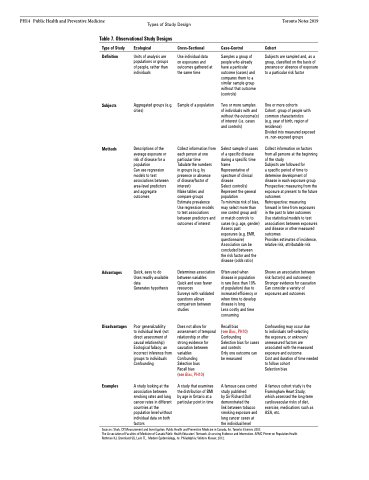Page 1232 - TNFlipTest
P. 1232
PH14 Public Health and Preventive Medicine Types of Study Design Table 7. Observational Study Designs
Toronto Notes 2019
Subjects are sampled and, as a group, classified on the basis of presence or absence of exposure to a particular risk factor
One or more cohorts
Cohort: group of people with common characteristics
(e.g. year of birth, region of residence)
Divided into measured exposed vs. non-exposed groups
Collect information on factors from all persons at the beginning of the study
Subjects are followed for
a specific period of time to determine development of disease in each exposure group Prospective: measuring from the exposure at present to the future outcomes
Retrospective: measuring forward in time from exposures in the past to later outcomes Use statistical models to test associations between exposures and disease or other measured outcomes
Provides estimates of incidence, relative risk, attributable risk
Shows an association between risk factor(s) and outcome(s) Stronger evidence for causation Can consider a variety of exposures and outcomes
Confounding may occur due to individuals self-selecting the exposure, or unknown/ unmeasured factors are associated with the measured exposure and outcome
Cost and duration of time needed to follow cohort
Selection bias
A famous cohort study is the Framingham Heart Study, which assessed the long-term cardiovascular risks of diet, exercise, medications such as ASA, etc.
Type of Study
Definition
Subjects
Methods
Ecological
Units of analysis are populations or groups of people, rather than individuals
Aggregated groups (e.g. cities)
Descriptions of the average exposure or risk of disease for a population
Can use regression models to test associations between area-level predictors and aggregate outcomes
Cross-Sectional
Use individual data on exposures and outcomes gathered at the same time
Sample of a population
Collect information from each person at one particular time
Tabulate the numbers in groups (e.g. by presence or absence
of disease/factor of interest)
Make tables and compare groups Estimate prevalence Use regression models to test associations between predictors and outcomes of interest
Determines association between variables Quick and uses fewer resources
Surveys with validated questions allows comparison between studies
Does not allow for assessment of temporal relationship or offer strong evidence for causation between variables
Confounding Selection bias Recall bias
(see Bias, PH10)
A study that examines the distribution of BMI by age in Ontario at a particular point in time
Case-Control
Samples a group of people who already have a particular outcome (cases) and compares them to a similar sample group without that outcome (controls)
Two or more samples of individuals with and without the outcome(s) of interest (i.e. cases and controls)
Select sample of cases of a specific disease during a specific time frame
Representative of spectrum of clinical disease
Select control(s) Represent the general population
To minimize risk of bias, may select more than one control group and/ or match controls to cases (e.g. age, gender) Assess past
exposures (e.g. EMR, questionnaire) Association can be concluded between the risk factor and the disease (odds ratio)
Often used when disease in population is rare (less than 10% of population) due to increased efficiency or when time to develop disease is long
Less costly and time consuming
Recall bias
(see Bias, PH10) Confounding
Selection bias for cases and controls
Only one outcome can be measured
A famous case control study published
by Sir Richard Doll demonstrated the
link between tobacco smoking exposure and lung cancer cases at the individual level
Cohort
Advantages
Disadvantages
Examples
Quick, easy to do Uses readily available data
Generates hypothesis
Poor generalizability
to individual level (not direct assessment of causal relationship) Ecological fallacy: an incorrect inference from groups to individuals Confounding
A study looking at the association between smoking rates and lung cancer rates in different countries at the population level without individual data on both factors
Sources: Shah, CP. Measurement and Investigation. Public Health and Preventive Medicine in Canada, 5e. Toronto: Elsevier, 2003.
The Association of Faculties of Medicine of Canada Public Health Educators’ Network. Assessing Evidence and Information. AFMC Primer on Population Health. Rothman KJ, Greenland SG, Lash TL. Modern Epidemiology, 3e. Philadelphia: Wolters Kluwer, 2012.


